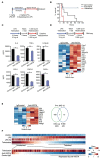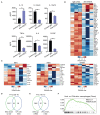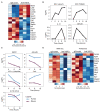VISTA Re-programs Macrophage Biology Through the Combined Regulation of Tolerance and Anti-inflammatory Pathways
- PMID: 33178206
- PMCID: PMC7593571
- DOI: 10.3389/fimmu.2020.580187
VISTA Re-programs Macrophage Biology Through the Combined Regulation of Tolerance and Anti-inflammatory Pathways
Abstract
We present the novel finding that V-domain Ig suppressor of T cell activation (VISTA) negatively regulates innate inflammation through the transcriptional and epigenetic re-programming of macrophages. Representative of VISTA re-programming is the ability of VISTA agonistic antibodies to augment LPS tolerance and reduce septic shock lethality in mice. This anti-inflammatory effect of anti-VISTA was mimicked in vitro demonstrating that anti-VISTA treatment caused a significant reduction in LPS-induced IL-12p40, IL-6, CXCL2, and TNF; all hallmark pro-inflammatory mediators of endotoxin shock. Even under conditions that typically "break" LPS tolerance, VISTA agonists sustained a macrophage anti-inflammatory profile. Analysis of the proteomic and transcriptional changes imposed by anti-VISTA show that macrophage re-programming was mediated by a composite profile of mediators involved in both macrophage tolerance induction (IRG1, miR221, A20, IL-10) as well as transcription factors central to driving an anti-inflammatory profile (e.g., IRF5, IRF8, NFKB1). These findings underscore a novel and new activity of VISTA as a negative checkpoint regulator that induces both tolerance and anti-inflammatory programs in macrophages and controls the magnitude of innate inflammation in vivo.
Keywords: VISTA; agonist; immunosuppression; macrophage; tolerance.
Copyright © 2020 ElTanbouly, Schaafsma, Smits, Shah, Cheng, Burns, Blazar, Noelle and Mabaera.
Figures





Similar articles
-
Immune-Checkpoint Protein VISTA Regulates Antitumor Immunity by Controlling Myeloid Cell-Mediated Inflammation and Immunosuppression.Cancer Immunol Res. 2019 Sep;7(9):1497-1510. doi: 10.1158/2326-6066.CIR-18-0489. Epub 2019 Jul 24. Cancer Immunol Res. 2019. PMID: 31340983 Free PMC article.
-
High-Affinity Anti-VISTA Antibody Protects against Sepsis by Inhibition of T Lymphocyte Apoptosis and Suppression of the Inflammatory Response.Mediators Inflamm. 2021 Jul 28;2021:6650329. doi: 10.1155/2021/6650329. eCollection 2021. Mediators Inflamm. 2021. PMID: 34366711 Free PMC article.
-
VISTA deficiency exerts anti-tumor effects in breast cancer through regulating macrophage polarization.Int Immunopharmacol. 2024 Jul 30;136:112365. doi: 10.1016/j.intimp.2024.112365. Epub 2024 May 30. Int Immunopharmacol. 2024. PMID: 38820964
-
VISTA as a context-dependent immune checkpoint: Implications for tumor immunity and autoimmune pathogenesis.Biochim Biophys Acta Rev Cancer. 2025 Jul;1880(3):189351. doi: 10.1016/j.bbcan.2025.189351. Epub 2025 May 9. Biochim Biophys Acta Rev Cancer. 2025. PMID: 40350098 Review.
-
Exploring the VISTA of microglia: immune checkpoints in CNS inflammation.J Mol Med (Berl). 2020 Oct;98(10):1415-1430. doi: 10.1007/s00109-020-01968-x. Epub 2020 Aug 27. J Mol Med (Berl). 2020. PMID: 32856125 Free PMC article. Review.
Cited by
-
Configuring Therapeutic Aspects of Immune Checkpoints in Lung Cancer.Cancers (Basel). 2023 Jan 16;15(2):543. doi: 10.3390/cancers15020543. Cancers (Basel). 2023. PMID: 36672492 Free PMC article. Review.
-
A pair of promising immune checkpoints PSGL-1 and VISTA from immunotolerance to immunotherapy.Biomark Res. 2024 Dec 2;12(1):151. doi: 10.1186/s40364-024-00693-8. Biomark Res. 2024. PMID: 39617949 Free PMC article. Review.
-
The role of inhibitory immune checkpoint receptors in the pathogenesis of Alzheimer's disease.J Mol Med (Berl). 2025 Jan;103(1):1-19. doi: 10.1007/s00109-024-02504-x. Epub 2024 Nov 27. J Mol Med (Berl). 2025. PMID: 39601807 Free PMC article. Review.
-
The role of VISTA engagement in limiting neutrophil-mediated inflammation.J Immunol. 2025 Jun 26:vkaf132. doi: 10.1093/jimmun/vkaf132. Online ahead of print. J Immunol. 2025. PMID: 40574311 Free PMC article.
-
VISTA regulates microglia homeostasis and myelin phagocytosis, and is associated with MS lesion pathology.Acta Neuropathol Commun. 2021 May 18;9(1):91. doi: 10.1186/s40478-021-01186-7. Acta Neuropathol Commun. 2021. PMID: 34006329 Free PMC article.
References
Publication types
MeSH terms
Substances
Grants and funding
LinkOut - more resources
Full Text Sources
Molecular Biology Databases
Research Materials
Miscellaneous

